A question that picture book writers often ask is: “Should I paginate my picture book before I send it to an editor or agent?” Today, Carol Hinz, editorial director at Millbrook Press and Carolrhoda Books at Lerner Publishing Group, shares a post she wrote addressing that very topic.
Take it away, Carol!
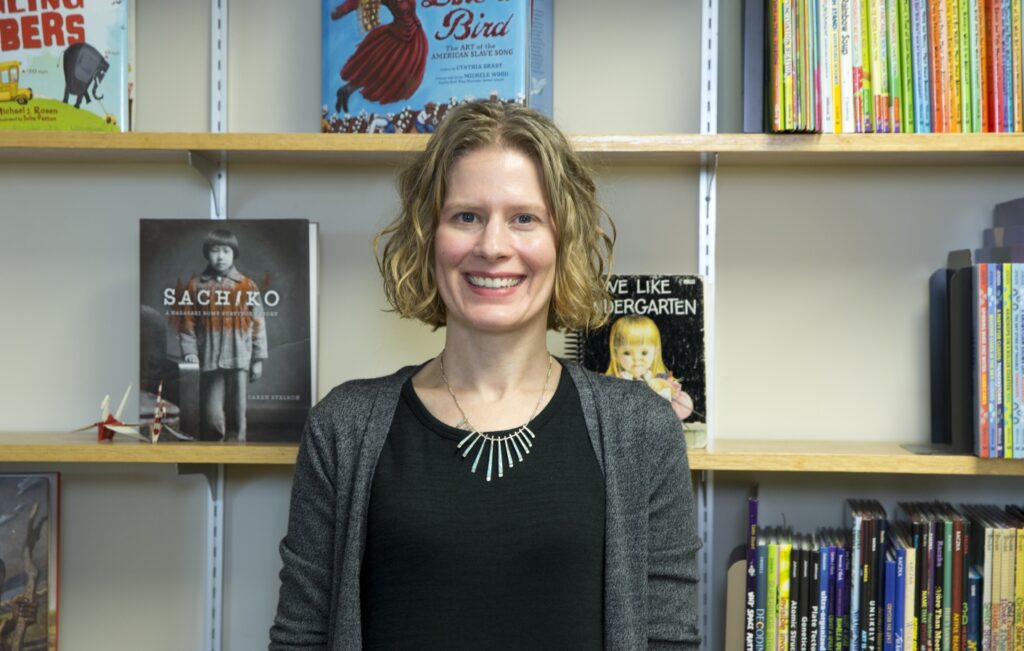
I love a paginated picture book manuscript. And I’ve come to realize that makes me a bit unusual in this industry.
The conventional wisdom in publishing is that authors shouldn’t paginate their picture book manuscripts. This makes sense in a lot of ways—the editor, art director, and illustrator may all have a vision for how to distribute the text across 32 or 40 pages. But I’d like to make a case for why it’s worth playing around with—whether or not the version you send to an agent or editor has those page breaks in place.
To start with the basics: What do I mean when I refer to paginating a picture book manuscript? Should you put in a page break every time you want to indicate a page turn? Please, no! (Unless someone specifically requests this.) Here’s how I do it.
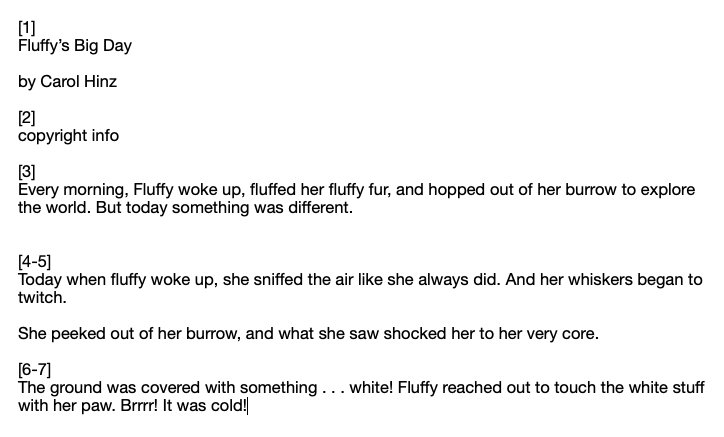
And, no, this is not a real book!
So why do I find it so meaningful to see those page breaks in a manuscript?
It comes down to this: A picture book manuscript isn’t an end product. Paginating helps all of us envision the text in its final form.
Ultimately, a picture book text isn’t going to exist as a text on its own. If a text feels fully complete without any accompanying images . . . it may not be a picture book. Now to be sure, a text can be wonderful, but the purpose of illustrations is not merely to render the text in visual form. The pictures should add an additional layer of meaning.
For a great example, take a look at Before Morning by Joyce Sidman, illustrated by Beth Krommes. The text says nothing about the mother being an airplane pilot who has to go to work–that’s all in the art.
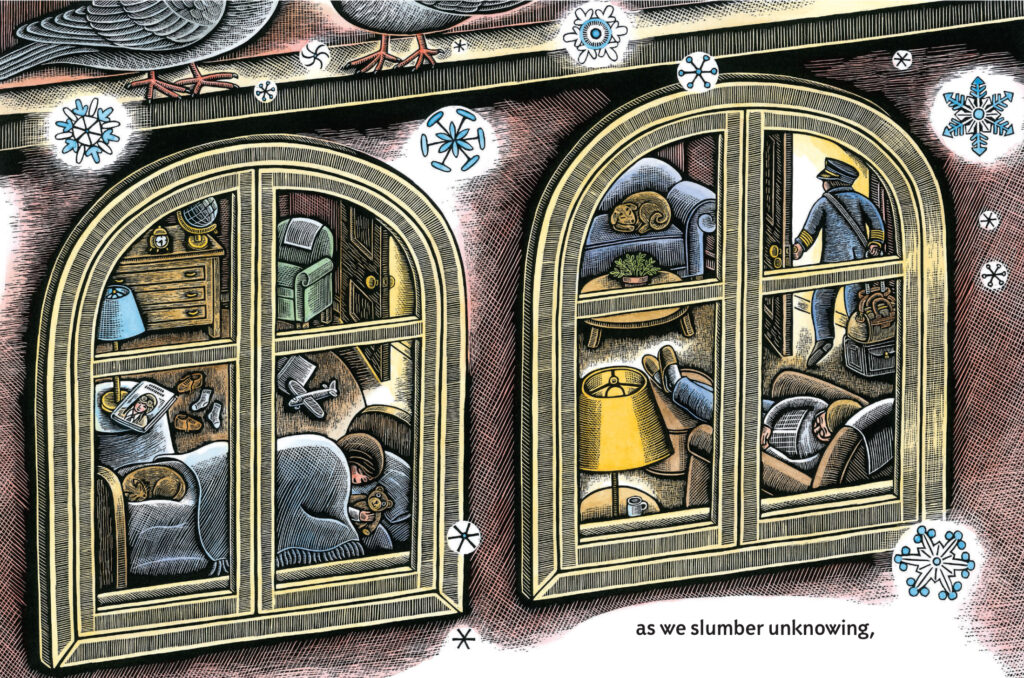
Because a picture book text will ultimately exist in picture book form, spread out across 32 pages, one of my jobs as editor is to think about how best to distribute the text. Does it make sense to have a roughly equal amount of text on every spread? Yes, often. But it can also be interesting to include a page with much more text than any other page–or no text at all. (Who doesn’t love a good wordless spread?)
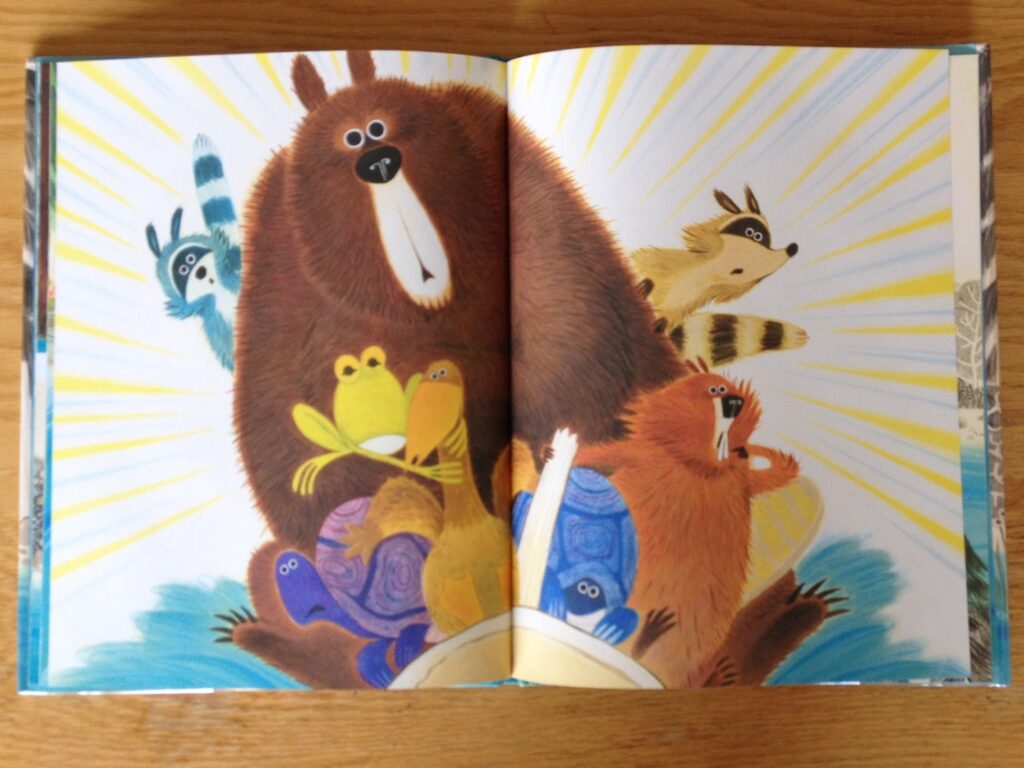
One of the two wordless spreads in Bear Came Along by Richard T. Morris,
illustrated by LeUyen Pham.
In a narrative picture book, it typically makes sense to give each scene its own spread. The page breaks help make the transition from one scene or one idea to the next. Yet if this rule is applied too rigidly, the pacing can become a little too predictable. On occasion, it might make sense to either speed up time or slow it down and linger on a particular scene or moment.
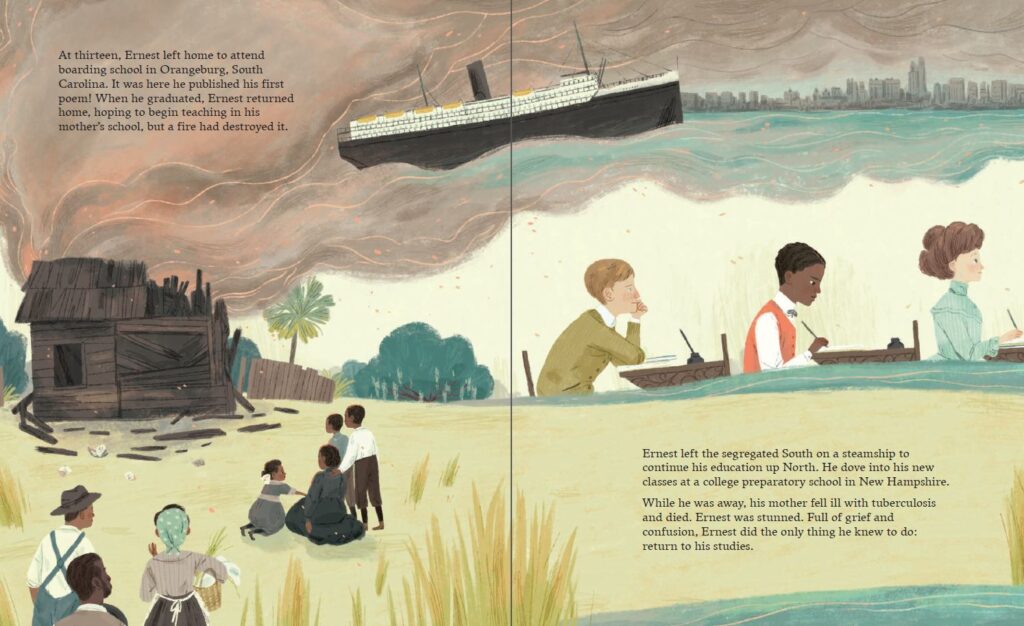
The Vast Wonder of the World by Mélina Mangal, illustrated by Luisa Uribe.
I regularly see picture book biography texts that are well done but just don’t completely grab me. A common problem with these is pacing. Everything in the subject’s life is given equal weight, so the highs don’t feel all that high nor do the lows feel all that low.
In expository picture books, giving each scene its own spread may still apply, but depending on the approach the author uses, the pagination may be pre-determined by the structure of the text.
Whether a book’s text is narrative or expository, I firmly believe that a page break has to mean something. The turn of a page should reveal something interesting, different, or new. And when I’m reading picture book submissions, I am looking for a reason for readers to keep on turning the pages.
Here are a few examples of pagination in books I’ve acquired or edited.
Flash and Gleam
To be sure, you can think about page breaks without literally inserting page numbers in your manuscript. For instance, in Flash and Gleam: Light in Our World by Sue Fliess, illustrated by Khoa Le, we knew from the beginning that each short, rhyming phrase would need its own page or spread.
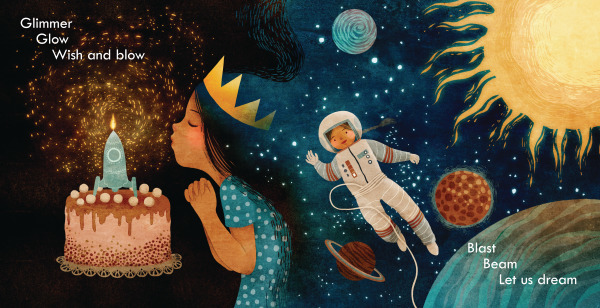
Whose Hands Are These?
And in Whose Hands Are These? A Community Helper Guessing Book by Miranda Paul, illustrated by Luciana Navarro Powell, we knew from the beginning that each questions would appear on a right-hand page . . .
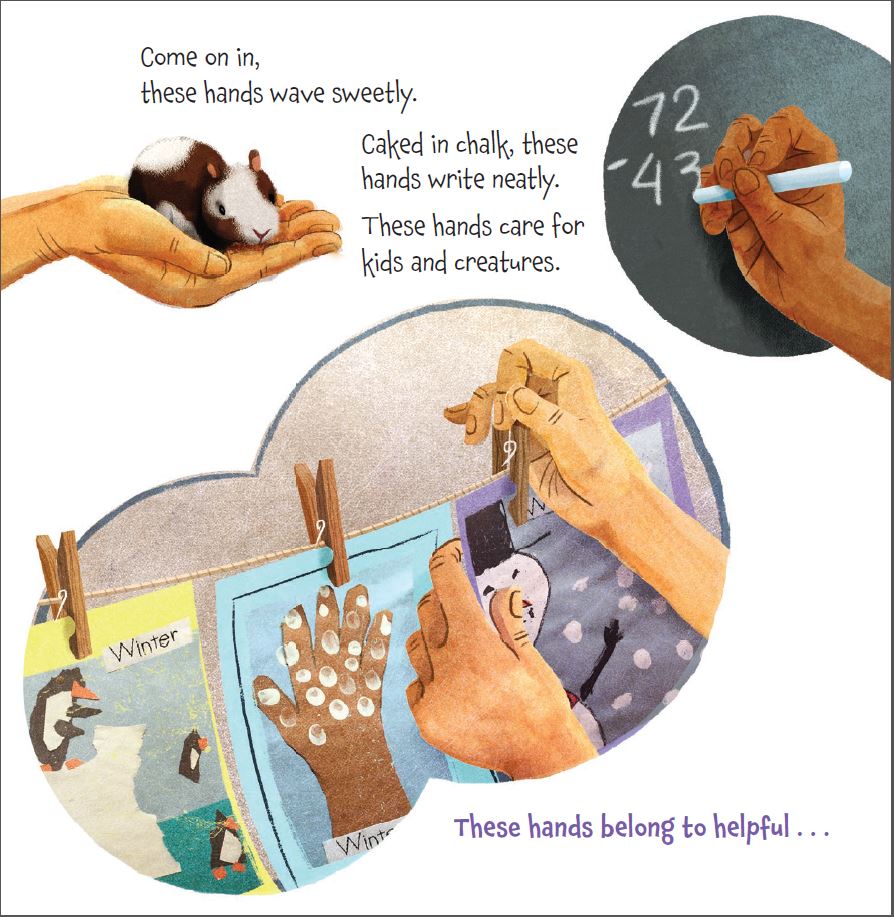
and the answer would be revealed after the page turn.

Strange Fruit
And in Strange Fruit: Billie Holiday and the Power of a Protest Song by Gary Golio and illustrated by Charlotte Riley-Webb, many spreads end in a statement that builds tension, prompts a question, or gets to the heart of what’s happening. Art director Danielle Carnito picked up on these statements and emphasized them with her choice of typography.
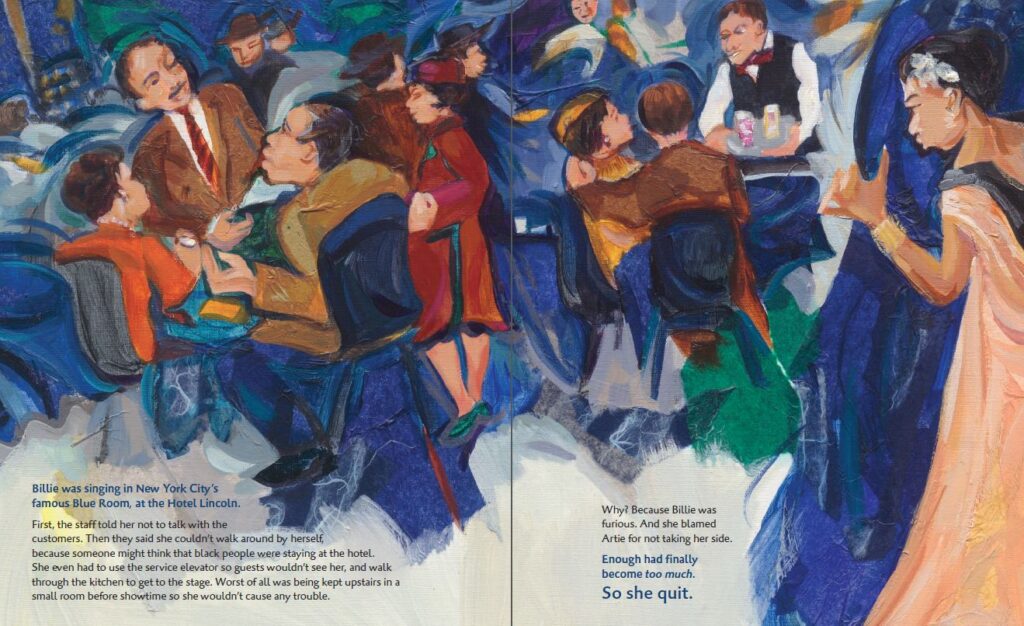
So why paginate your manuscript? When I look at a paginated picture book manuscript, I get an immediate sense of the book’s pacing and how much text might be on a given spread. And that helps me start thinking about how the text will look in book form and what the possibilities might be for illustration.
Do you absolutely have to start paginating your picture book manuscripts? Well . . . no. But particularly for writers who are new to the picture book form, I’d suggest paginating one of your manuscripts just to see what happens when you spend time thinking about those all-important page breaks. As short as picture books are, they contain a world of possibilities!

Great explanation, Carol. Thanks, Pat!
This is very helpful. Thanks
This is very helpful…thank you so much for sharing these insights!
I love exploring the possibilities of a wordless two page spread! How better to emphasize a really significant, emotional turning point? Helpful post as always – thank you!
Thank you Carol, This has been very helpful to me.
Such valuable and useful information about pagination, along with excellent titles. Thank you, Carol.
Suzy Leopold
I do believe in pagination. It helps me delete unnecessary words.
Thank you, Carol. I understand why you like pagination. It gives some of the first visual possibilities for a picture book.
Wonderful. Thank you so much.
I have started doing this with all my manuscripts. It really makes me “see” page turns.
Great post! I like this: “A page turn has to mean something.” Thanks, Carol & Pat!
This is really a helpful post. Thanks!
Such a timely post. I was jus thinking about pagination today…
To paginate,
or not to paginate,
that is the question.
I have begun paginating my mss after the first few drafts. It helps me feel the rhythm and pacing. I also like making a PowerPoint out of mine to see text distribution, how many words on each spread. This is a powerful post and the examples help drive home your thinking as an editor. Very helpful for those who are writers only. Ty.
Great post! Thanks Carol. Pagination helps me think about how the story unfolds- the beginning, middle and end.
Thank you! This was helpful and I loved your examples.
Interesting! Nice to see this perspective.
I love this and shared it with one of my critique groups that has some newer PB writers. I always look forward to Carol’s wisdom!
Pagination, like creating a dummy, truly does help with pacing, tightening text, and so many things that move a story from okay to polished. I also find it helpful to include pagination when typing mentor texts. That’s a great way to see how it all comes together in a published story. Thank you to both Carol and Pat for sharing.
This is a beautifully illustrated tutorial. I’ll be teaching Writing Picture Books (again) this summer in the Hollins University Children’s Writing and Illustrating MFA program. As an author AND illustrator, I always paginate every script and I teach this skill to my student writers. Recognizing and respecting the vital and equal role of the illustrator is essential to learning the PB form. Your advice is right on!
Wonderful article with working information. I have always felt that page breaks not only assist with the story and the illustrations, but also adds to the flow and rhythm of the story. As a former educator, I feel it helps in the reading and involvement with the story and keeps the eye of the reader moving and being an active participant.
As an Indie author and publisher I have incorporated these points that you share. With 5 award-winning picture books and the 6th on its way, I still love what I do after 12 years. As President of Reading Is Fundamental of Southern California, literacy is my passion and we help 61,000 children with free, brand new books 3 times a year to help build home libraries. Looking forward to more good tips, as we learn each and every day!
I loved Carol’s post. Pagination helps me see how the book could be laid out. I’m so glad to hear an editor finds it helpful too. Thanks!
What a great post! Thank you! Very useful. 🙂
Thank you so much to all who have commented! I am glad this information is helpful, and I wish everyone well with their writing!
Excellent post with great examples. I paginate my manuscripts, but I thought the numbers had to be removed before submitting. I’m so glad I read this post!
Thank you, Carol! Nice to hear an editor’s opinion on this:)
Thanks so much – I enjoyed hearing about this topic from your editorial viewpoint and seeing the excellent examples.
It was so interesting to hear from an editor’s point of view. I often paginate manuscripts to check pacing and length, but I don’t think I’ve ever submitted one that way. Thanks for sharing your insights, Carol!
When a publisher asked me to submit a manuscript with 14 spreads. What does it mean? Do I need to insert page break in every narrative of my story?
Thank You and God Bless.
Thank you so much — this helped me make the decision to keep my pagination in for my next PB submission!
Very helpful. I’m a new PB writer and was wondering about this!
Thank you Carol for sharing not only these suggestions for writing more polished PB manuscripts, but also for sharing a little of your own process. Picture books surely do hold many possibilities and paginating PB’s seems to help us realize more of their potential.
How on earth did I miss this post last year??? Glad to have it now! Thanks, Carol!
Thank you, Carol. My picture book is in the epistolary structure. I paginated it to examine the power of the page turns.
I appreciate this article and the insights you’ve shared! I find that paginating helps me with more effective scenes, transitions, and pacing. Thanks to Kid Lit 411 for sharing again!
Thanks for sharing. Paginating a narrative picture book can also help with structuring the sorry arc.